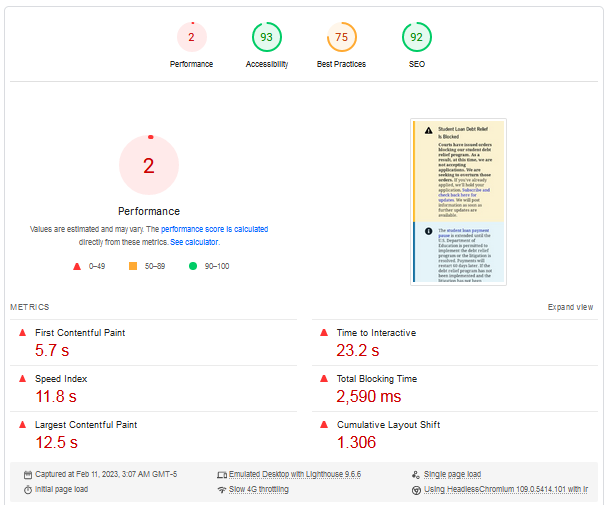There could be a number of reasons why the Free Application for Federal Student Aid (FAFSA) website is slow, including high traffic volume, website maintenance, technical difficulties, and internet connectivity issues. grid. The website can experience high traffic especially at peak times, such as the start of the FAFSA filing season or the deadlines to submit the form. In addition, the website may be undergoing maintenance to improve performance or fix bugs, which can also cause slowness. In some cases, the website's server could face technical difficulties that affect its speed. Finally, problems with the user's internet connection or the network can also cause slow access to the website. If you experience slow performance on the FAFSA website, it might be a good idea to try accessing it later or check the Federal Student Aid website for updates or maintenance notifications.
FAFSA website speed down due to increased traffic
According to SEMrush's domain overview, the FAFSA website has seen a significant increase in traffic. In fact, visits to the FAFSA website doubled from 6 million to 12 million per month from 2022 to 2023. This could be one reason why the FAFSA website is slower than it was before 2022.

Slow FAFSA website performance according to Google PageSpeed metrics
These Google PageSpeed performance metrics indicate that the FAFSA website is relatively slow in terms of loading and user interactivity. In the FAFSA Website Performance Report, PageSpeed recommends, among other things, reducing unused JavaScript with an estimated savings of 5.10 s.

A First Contentful Paint (FCP) of 5.7 seconds is relatively long, as it represents the time it takes for the first meaningful content to appear on the page. Ideally, the FCP should be less than 2 seconds to provide a good user experience.
The Time to Interactive (TTI) of 23.2 seconds is also quite long, representing the time it takes for the page to be fully interactive. A TTI greater than 10 seconds may indicate that the user might need to wait a while before they can start using the site.
The speed rating of 11.8 seconds is also relatively high, which is a measure of how quickly the page appears visually complete.
A Total Block Time of 2,590 ms is also relatively high, as it represents the amount of time the main thread was blocked and unable to respond to user input. This can result in a slow and unresponsive user experience.
The Largest Contentful Paint (LCP) of 12.5 seconds is relatively high, as it represents the rendering time of the largest content element on the page. An LCP less than 2.5 seconds is considered to offer a good user experience.
The Cumulative Layout Shift (CLS) of 1,306 is also relatively high, which measures the visual stability of the page. A high CLS score may indicate that page elements are scrolling and changing as the page loads, which can be annoying to the user. Overall, these metrics suggest that there is room for improvement in the performance of the FAFSA website and efforts should be made to optimize its speed and interactivity.
Slowness of the FAFSA website according to user experiences and opinions
Workalibur analyzed 89 tweets from November 2022 to February 2023, finding that 65% had issues with the performance of the FAFSA website. The place down detector reports on these 89 tweets. The most common website performance issues reported by parents and students are: website down, not working, not available, broken, can't login. Some users report that the FAFSA website is down due to maintenance. But most say they don't know why.
How can the FAFSA website not slow down and crash?
According to BuiltWith data, the FAFSA website uses AngularJS, Akamai CDN, and CrUX to collect user experience data.
CrUX is a data collection system that collects information about how real users interact with websites. This website is included in the user experience data collected by Google Chrome and is therefore considered popular enough on the Internet. Relative measure of site popularity within the CruX dataset, as measured by the total number of navigations to the origin. This site is in the top 5k.
Akamai Content Delivery Network provides a distributed computing platform for the global delivery of content and applications on the Internet.
AngularJS is a mobile and desktop framework.
Here is an action plan based on this information:
- Use of CrUX data: CrUX collects data about how real users interact with websites. This data should be used to understand how users interact with the FAFSA website and to identify areas for improvement.
- Monitoring Performance with Akamai CDN: The Akamai Content Delivery Network provides a distributed computing platform for the global delivery of content and applications on the Internet. This can be used to monitor performance and identify bottlenecks in the delivery of content to users.
- Optimize AngularJS code: AngularJS is a powerful framework for building web applications, but it can also contribute to slow page load times if not optimized. The code must be reviewed and optimized to improve performance and provide a better user experience.
- Invest in additional server resources: With web traffic doubling to 12 million hits per month, investing in additional server resources or a better hosting solution may be necessary to handle increased traffic and provide stable performance.
- Minimize HTTP requests: The number of HTTP requests made by a page can significantly affect its performance. Minimizing these requests can speed up the page.
- Implement lazy loading: Lazy loading is a technique where images and other resources are loaded only when they are needed, rather than all at once when the page loads. This can improve performance by reducing the amount of data that needs to be loaded.
- Use compression: Compressing large files, such as images and videos, can significantly reduce file size and improve page load times.
- Monitor network performance: If there are network issues that are causing slowness, monitoring network performance can help identify bottlenecks and potential solutions.
By incorporating data from CrUX and the capabilities of the Akamai CDN, it is possible to gain a better understanding of how users interact with the FAFSA website and improve performance. The remaining tasks should be prioritized based on their performance impact and available resources, to ensure improvements are made in the shortest possible time and at the lowest cost.
FAFSA Website Risk Analysis
In our experience at Precise Future, we have been able to verify that a slow website is a warning sign of the risk of server crashes at times of peak traffic. Therefore, problems must be resolved before they escalate. This is a risk analysis performed for the FAFSA website based on the data collected.
- Increased traffic: With web traffic doubling to 12 million visits per month, there is a risk of server crashes and downtime if the website is not optimized to handle the increased traffic.
- Unoptimized AngularJS code: AngularJS can contribute to slow load times if not optimized, which can result in frustrated users and possible crashes during peak traffic times.
- Limited server resources: If the current hosting solution does not have enough resources to handle increased traffic, this can result in slow performance and possibly crashes during peak traffic.
- Network performance issues: If there are bottlenecks in the delivery of content to users, this can result in slow performance and potentially crashes during peak traffic.
- High number of HTTP requests: The number of HTTP requests made by a page can significantly affect its performance. If the number of requests is high, it can result in slow performance and potentially crashes during peak traffic.
- Large file sizes: If large files, such as images and videos, are not compressed, this can result in slow performance and potentially crashes during peak traffic.
- Inadequate monitoring: If network and performance issues are not being monitored, this can result in issues that escalate and potentially crash the website during peak traffic.
By addressing these risks, it is possible to reduce the risk of server crashes and improve the overall performance of the FAFSA website, even during times of peak traffic. Implementing the tasks outlined in the action plan above can help mitigate these risks and improve the reliability of the website for users.
Executive summary of the analysis of the causes of the slowness of the FAFSA website
The FAFSA website has experienced a significant increase in traffic, with visits doubling from 6 to 12 million per month. This, combined with unoptimized AngularJS code and limited server resources, has led to slow load times and a risk of server crashes during peak traffic times.
To address these issues, an action plan has been proposed that includes:
- Optimize AngularJS code to reduce page load times.
- Upgrade the hosting solution to provide sufficient resources to handle the increased traffic.
- Implement a Content Delivery Network (CDN) to improve network performance.
- Minimize the number of HTTP requests made by the page.
- Compress large files, such as images and videos.
- Monitor performance and network issues to prevent problems from escalating.
By implementing these tasks, you can reduce the risk of server crashes, improve the performance of the FAFSA website, and provide a better experience for students.
Thanks to OpenAI and ChatGPT
This analysis was performed with the assistance of ChatGPT. ChatGPT can serve as an executive assistant by providing comprehensive research and analysis of complex issues, as demonstrated in this review. With the ability to process vast amounts of information and provide concise, actionable recommendations, ChatGPT can help decision makers effectively address challenges and make informed decisions.

